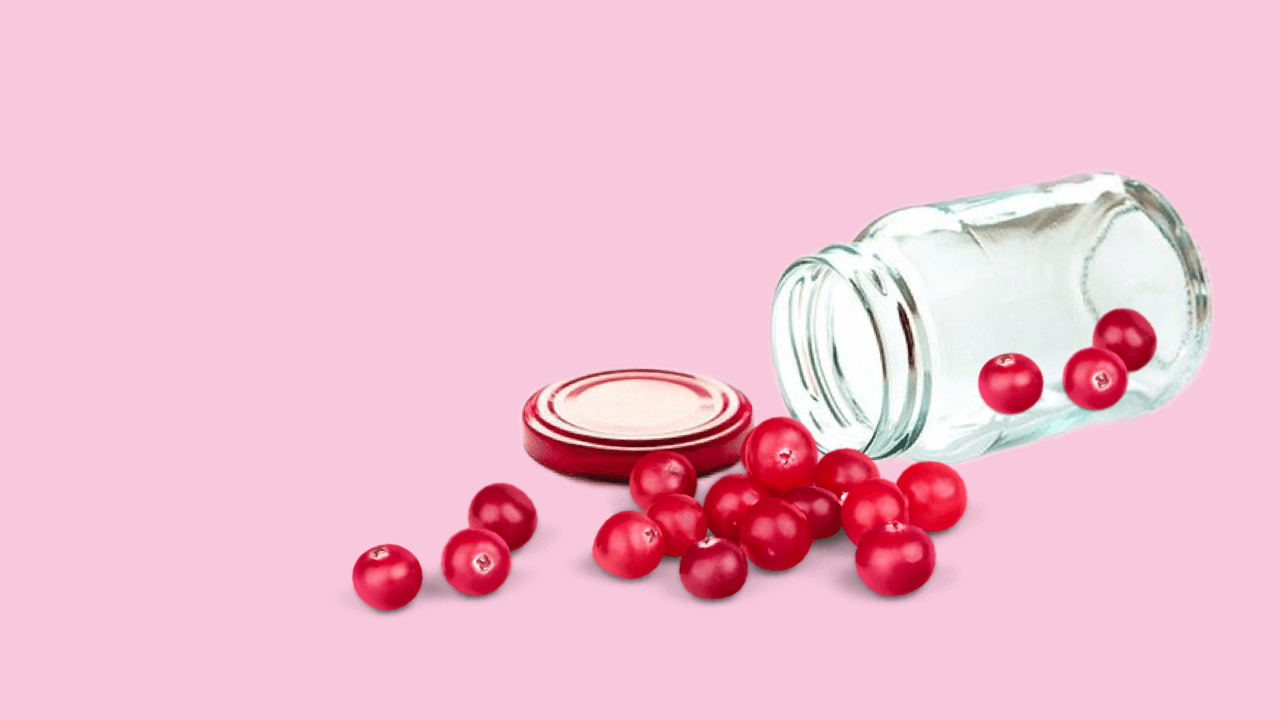Have you ever wondered about the efficacy of cranberry juice for urine health? If you’ve ever experienced the discomfort of a urinary tract infection (UTI), you’re not alone.
Recurrent UTIs are a common problem, particularly for women, and finding effective prevention methods can be challenging. You might have heard about pure cranberry juice and cranberry supplements as potential home remedies for UTI prevention. But what does the science say about their effectiveness?
For centuries, cranberry products have been used to support urinary health. Native Americans first utilized cranberries for their medicinal properties, and today, pure cranberry juice, cranberry extract, and cranberry supplements like pills and capsules are popular for their potential to prevent bladder infections and UTIs. The active ingredient in cranberries, type proanthocyanidins (PACs), is believed to prevent E. coli, the bacteria most often responsible for UTIs, from adhering to the bladder wall.
While research has traditionally produced conflicting evidence, a new study published in Cochrane Reviews confirms that cranberries (and other cranberry products!) are an effective means of preventing UTIs before they arrive.
Keep scrolling, and our team will break down the benefits of consuming cranberry juice for urine health. (Plus, some additional at-home remedies for a healthy urinary tract.)
What is Pure Cranberry Juice?
Essentially, pure cranberry juice is what you get when you squeeze a cranberry. (And if you didn’t already know, cranberries are closely related to blueberries, bilberries, and huckleberries.) Cranberry juice is bursting with antioxidants, and it contains plenty of nutrients that help our bodies ward off infections and boost overall health.
Specifically, unsweetened, pure cranberry juice is a tremendous source of both vitamin C and vitamin E. It also contains several other essential vitamins and minerals:
- vitamin C: 26% of the daily value (DV)
- vitamin E: 20% of the DV
- copper: 15% of the DV
- vitamin K1: 11% of the DV
- vitamin B6: 8% of the DV
Benefits of Cranberry Juice
Because cranberry juice contains ample vitamins and minerals, it has numerous health benefits:
Supports Heart Health
Inflammation damages blood vessels over time – including the arteries – and damaged arteries attract plaque, which causes atherosclerosis. However, cranberry bioactives have anti-inflammatory properties. In fact, a 2019 study on men who are overweight and obese revealed that the daily intake of a high-polyphenol cranberry beverage for eight weeks improved several risk factors for heart disease.
Contains Antioxidants
As we mentioned, cranberry juice contains powerful phytochemicals that function as antioxidants (vitamin C, vitamin E, quercetin). Antioxidants protect the body from damage caused by free radicals. And if you didn’t already know, free radical damage contributes to the overall aging process and is a risk factor for developing chronic diseases (like cancer and heart disease).
However, thanks to their antioxidative properties, research suggests that cranberries play a role in preventing cancer. Additionally, a diet rich in whole fruits, berries, and vegetables is associated with decreased cancer risk.
Improves Digestive Health
If you primarily consume an animal-based diet, cranberries can help put good bacteria into your digestive system. And while more research is needed, there’s a chance that consuming cranberries could help prevent colon and gastrointestinal cancer.
Prevents Cavities
Researchers believe that the a-type proanthocyanidins found in cranberries are also responsible for preventing bacteria formation in the mouth. By controlling the harmful acids in your mouth, cranberries could help prevent cavities, tooth decay, gum disease, and oral cancer.
What Is a UTI?
Research tells us that approximately 25% to 40% of American women aged 20 to 40 have had a UTI. Essentially, they develop when bacteria enter and infect the urinary tract.
Urinary tract infections can affect any part of the urinary system, including the bladder, kidneys, and urethra. The vast majority of UTIs are caused by Escherichia coli (E. coli), a type of bacteria that normally lives in the intestines. The growth of E. coli is actually responsible for 90% of UTIs. When E. coli enters the urinary tract, it can adhere to the bladder wall, leading to a bladder infection.
UTIs are particularly common in adult women, young women, pregnant women, and older women, with sexual activity and certain medical conditions like interstitial cystitis or bladder issues increasing the risk factors for infection.
If left untreated, further effects of a UTI include poor kidney health and complications like sepsis and other infections. Therefore, prompt diagnosis and treatment of UTIs are essential.
Symptoms of UTIs
As we mentioned, it’s important to seek treatment for a UTI as soon as possible. While they don’t always come with symptoms, UTI indicators include:
- Foul-smelling urine
- A burning sensation during urination
- A strong urge to pee – that doesn’t necessarily go away
- Frequent urination – and passing small amounts of urine
- Discolored urine – either cloudy or bright red, pink, brown, or bloody
- Pelvic or abdominal pain — especially in the center of the pelvis or around the pubic bone
How Cranberry Juice Can Help Prevent UTIs
While cranberry supplements have ample benefits for women’s health (see above), it’s best known for UTI prevention. Cranberries are rich in proanthocyanidins (PAC) – which is a type of polyphenol with incredible antibacterial and antioxidant properties. And researchers found that PAC inhibits the formation of bacterial biofilm in the urinary tract lining. It also deters the activation of uropathogenic E.coli “virulence genes at an early stage in the gut reservoir.”
A global study recently revealed that cranberry juice (and cranberry supplements) reduce the risk of repeated symptomatic UTIs in women by over a quarter. The study also found that it reduced the risk in children by over half and in people susceptible to UTIs following medical interventions by 53%.
Nevertheless, given the low risk of side effects and potential benefits, many healthcare providers consider cranberry juice a good idea for UTI prevention. Opting for unsweetened cranberry juice is important to avoid added sugars that could negate the benefits. Incorporating pure cranberry juice into your routine, alongside other preventive measures and medical interventions as advised by your healthcare provider, might be worth trying, especially for those dealing with frequent UTIs or other bladder problems.
Other Remedies For A Healthy Urinary Tract
While drinking cranberry juice is a fantastic prevention technique, it won’t necessarily help a UTI once it has begun. So, if you or a loved one is experiencing symptoms of a UTI (including fevers, frequent urination, abdominal pain, abnormal urine, and overall achiness), it’s best to schedule an appointment with your doctor. While UTIs can sometimes go away on their own, antibiotics are often required.
As we mentioned, cranberry juice is a phenomenal at-home remedy to prevent UTIs from occurring. But if you don’t have any in your fridge or pantry, here are some additional remedies to support a healthy urinary tract:
Drink Lots of Water
Not only do fluids add volume to your urine, but staying hydrated ensures that you’re urinating often. Additionally, water helps dilute and flush out any UTI-causing bacteria. (Both of which reduce your risk of developing an infection.) Experts recommend drinking at least two liters of fluid every day and urinating every three hours.
Wipe Carefully After Using the Restroom
Infections develop when bacteria from the rectum end up in the vagina or urethra. Therefore, try your best to wipe front to back. Clean the area around your anus gently, and never wipe twice using the same tissue.
Urinate After Sex
Many health authorities — including the Centers for Disease Control and Prevention — recommend urinating after sex as a means of UTI prevention. Doing so flushes bacteria that are close to the urethra and prevents them from entering the urinary tract. And while some research suggests that peeing after sex does not have any measurable protective effects, experts still agree that it’s a safe and reasonable thing to do.
Normalize Your Vaginal pH
Menopause can change a woman’s vaginal pH – making it harder for good bacteria to survive and easier for UTI-causing bacteria to take root. Therefore, if you’re in menopause or post-menopausal, you can lower your UTI risk by normalizing your vaginal pH:
- Consider using boric acid suppositories. Boric acid is clinically proven to treat bacterial vaginosis (BV).
- Incorporate more probiotics into your diet. Lactobacilli (aka “good” bacteria) are found in probiotic supplements and occur naturally in fermented foods. Not only do these bacteria fight off infection, but they help keep your vaginal pH balanced.
- Consider taking garlic supplements. According to a 2014 study, garlic tablets might be as effective as oral antibiotics for treating the symptoms of a vaginal yeast infection or BV. (And they have fewer side effects.)
- Find ways to destress. One study linked spikes in cortisol (the stress hormone) to BV. Therefore, women should find regular ways to destress including exercise, breathwork, listening to music, devoting time to hobbies, etc.
- Stop smoking. Researchers found that nonsmokers had a larger amount of lactobacillus (a bacteria vital to vaginal health) in their vaginal microbiota than their smoking counterparts.
- Wear the right underwear. Opt for underwear that’s made from natural, breathable materials (like cotton) and wash it with a hypoallergenic detergent. Additionally, change your underwear during the day if you experience moisture buildup and go panty-free at night.
- Use barrier methods during sex. Research confirms that increased exposure to semen — which has an alkalizing effect on the vagina — increases your risk for bacterial vaginosis.
- Be mindful of how you clean your vagina. Even though the vagina is self-cleaning, many women reach for fragrant cleaning products when symptoms of BV or yeast infections arise. However, research reveals that douching is strongly linked to BV. So instead, gently rinse your vagina with warm water (and nothing more).
Change Your Birth Control
Spermicide-treated condoms or diaphragms can cause unwanted bacteria growth and increase your risk of getting a UTI. So, if you experience frequent UTIs and use either of these birth control methods, you might consider switching to another option.
Conclusion: Cranberry Juice for Urine Health
So, there you have it. Drinking cranberry juice for urine health isn’t just a myth. Not only are cranberries rich in PAC – which inhibits the formation of bacterial biofilm in the urinary tract — but they deter the activation of uropathogenic E.coli. And if that isn’t enough, researchers recently discovered that drinking cranberry juice significantly reduces the risk of repeated symptomatic UTIs.
Pure cranberry juice and cranberry supplements, including cranberry extract, pills, and capsules, offer a promising approach to UTI prevention. While some clinical trials and reviews, such as those from the Cochrane Database of Systematic Reviews, show mixed results, the benefits of cranberry products cannot be dismissed entirely.
Consulting with a healthcare provider is essential to develop a comprehensive UTI prevention strategy that includes cranberry products as part of a range of methods. As ongoing research and new studies continue to explore the effectiveness of cranberries, the potential for these natural remedies to support urinary health remains a very positive finding.
Want more women’s wellness info? Head to the wellness section of our blog for more guides like this one.




